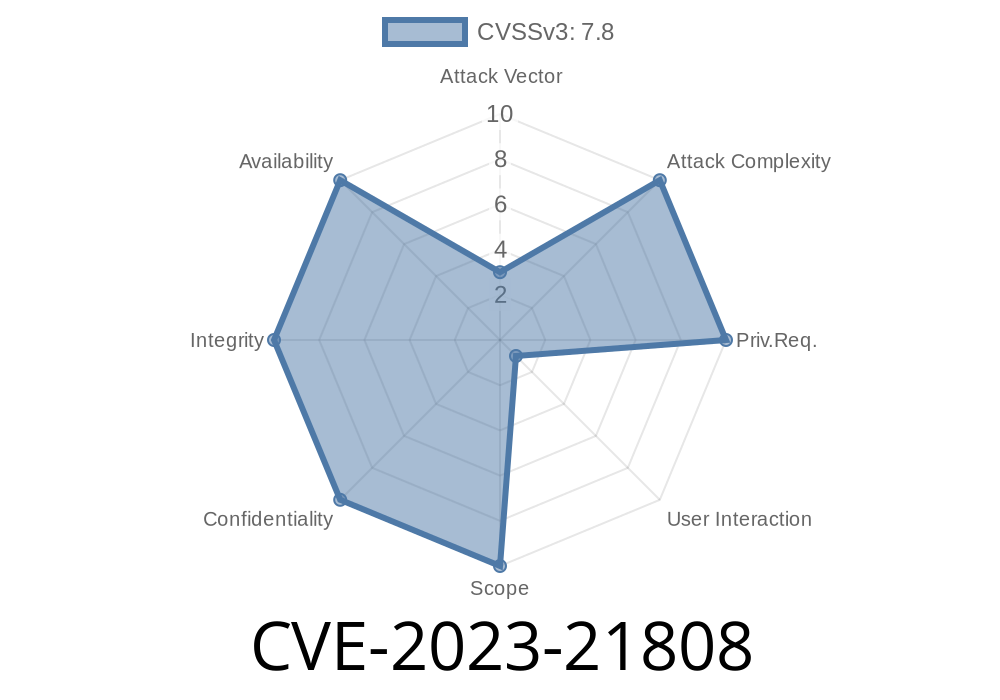Security researchers recently discovered a critical remote code execution (RCE) vulnerability in Microsoft's .NET framework and Visual Studio development environment. Identified as CVE-2023-21808, this exploit allows an attacker to remotely execute arbitrary code on an affected system by leveraging a design flaw within the software. Mitigating this vulnerability is vital as it could potentially compromise millions of applications powered by the .NET framework and host systems.
In this post, we'll discuss the technical details of CVE-2023-21808, review the code snippets that shed light on the vulnerability, and explore potential exploitation scenarios. Additionally, we'll also provide links to official sources and advisories that outline feasible mitigation strategies.
Technical Analysis
The CVE-2023-21808 vulnerability stems from a design flaw in the .NET framework and Visual Studio's handling of deserialization processes. When an affected application deserializes a specially crafted data stream, an attacker can remotely execute arbitrary code on the target system.
Here is a sample code snippet demonstrating the flaw in how .NET framework handles deserialization
DataFormatter formatter = new DataFormatter();
MemoryStream ms = new MemoryStream();
BinaryWriter bw = new BinaryWriter(ms);
bw.Write(someData);
bw.Write(someMoreData);
bw.Close();
ms.Seek(, SeekOrigin.Begin);
formatter.Deserialize(ms);
The issue here is that the deserialization process does not adequately validate or sanitize the data stream's contents, putting the application and the host system at risk.
Links to Original References
For more information on the technical aspects of the .NET framework and Visual Studio Remote Code Execution Vulnerability, you can refer to the following official sources:
1.Microsoft Security Advisory: https://msrc.microsoft.com/update-guide/vulnerability/CVE-2023-21808
2.NIST: https://nvd.nist.gov/vuln/detail/CVE-2023-21808
3.CVE Details: https://cve.mitre.org/cgi-bin/cvename.cgi?name=CVE-2023-21808
Exploitation Scenarios
Given that the .NET framework is widely used to create and deploy web applications, databases, games, and IoT devices, the impact of CVE-2023-21808 is extensive. Some potential exploitation scenarios include:
1. Remote compromise of a web application running on .NET, allowing an attacker access to sensitive information or control over server infrastructure.
2. Remote manipulation of an IoT device relying on the .NET framework, opening doors to surveillance, espionage, or sabotage.
3. Gaining access to source code repositories hosted within a Visual Studio development environment, leading to intellectual property theft, code manipulation, or deployment of malicious updates.
Mitigation Strategies
One of the most effective ways to mitigate CVE-2023-21808 is to apply security patches and updates released by Microsoft. Keep your .NET frameworks and Visual Studio installations current by enabling auto-updates or frequently checking for updates manually. Additionally, consider implementing proper input validation, access controls, and code hardening to limit potential exploit windows and reduce the attack surface.
Conclusion
CVE-2023-21808 represents a significant security risk in the .NET framework and Visual Studio development ecosystem. By understanding the technical aspects of this vulnerability and applying practical mitigation strategies, developers and system administrators can minimize the impact and protect their applications and infrastructure from potential exploitation scenarios. Keep track of the official advisories and updates to stay abreast of the latest developments and stay safe in the ever-evolving world of cybersecurity.
Timeline
Published on: 02/14/2023 21:15:00 UTC
Last modified on: 02/24/2023 18:56:00 UTC
